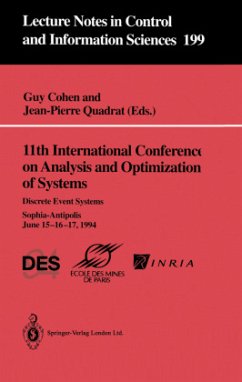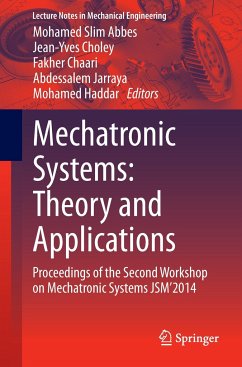
Digital & Analog Communication Systems: International Edition

PAYBACK Punkte
58 °P sammeln!
For second and third year Features + Benefits
MATLAB illustrative examples and plots and practice in files.
Minimum-level mathematics used throughout.
Communication system building blocks Describes down converters, phase-locked loops and other essential blocks used in receivers and transmitters.
Noise performance analysis of communication systems.
Case studies of modern communication systems.
Discussion of communication system standards.
Over 500 problems with selected answers.
Study-aid examples and homework problems, many of which are computer-based and marked with a personal computer icon.
Extensive pedagogy Includes chapter objectives, summaries, lists of key terms, and a glossary with extensive references.
Preface
List of Symbols
Chapter 1. INTRODUCTION
11 Historical Perspective
12 Digital and Analog Sources and Systems
13 Deterministic and Random Waveforms
14 Organization of the Book
15 Use of a Personal Computer and MATLAB
16 Block Diagram of a Communication System
17 Frequency Allocations
18 Propagation of Electromagnetic Waves
19 Information Measure
110 Channel Capacity and Ideal Communication Systems
111 Coding
Block Codes,
Convolutional Codes,
Code Interleaving,
Code Performance,
Trellis-Coded Modulation,
112 Preview
113 Study-Aid Examples
Problems
Chapter 2. SIGNALS AND SPECTRA
21 Properties of Signals and Noise
Physically Realizable Waveforms
Time Average Operator
DC Value
Power
RMS Value and Normalized Power
Energy and Power Waveforms
Decibel
Phasors
22 Fourier Transform and Spectra
Definition
Properties of Fourier Transforms
Parsevals Theorem and Energy Spectral Density
Dirac Delta Function and Unit Step Function
Rectangular and Triangular Pulses
Convolution
23 Power Spectral Density and Autocorrelation Function
Power Spectral Density
Autocorrelation Function
24 Orthogonal Series Representation of Signals and Noise
Orthogonal Functions
Orthogonal Series
25 Fourier Series
Complex Fourier Series
Quadrature Fourier Series
Polar Fourier Series
Line Spectra for Periodic Waveforms
Power Spectral Density for Periodic Waveforms
26 Review of Linear Systems
Linear Time-Invariant Systems
Impulse Response
Transfer Function
Distortionless Transmission
Distortion of Audio, Video, and Data Signals
27 Bandlimited Signals and Noise
Bandlimited Waveforms
Sampling Theorem
Impulse Sampling and Digital Signal Processing (DSP)
Dimensionality Theorem
28 Discrete Fourier Transform
Using the DFT to Compute the Continuous Fourier Transform
Using the DFT to Compute the Fourier Series0
29 Bandwidth of Signals
210 Summary
211 Study-Aid Examples
Problems
Chapter 3 BASEBAND PULSE AND DIGITAL SIGNALING 31 Introduction
32 Pulse Amplitude Modulation
Natural Sampling (Gating)
Instantaneous Sampling (Flat-Top PAM)
33 Pulse Code Modulation
Sampling, Quantizing, and Encoding
Practical PCM Circuits
Bandwidth of PCM Signals
Effects of Noise
Nonuniform Quantizing: _-Law and A-Law Companding
V.90 56-kb/s PCM Computer Modem
34 Digital Signaling
Vector Representation
Bandwidth Estimation
Binary Signaling
Multilevel Signaling
35 Line Codes and Spectra
Binary Line Coding
Power Spectra for Binary Line Codes
Differential Coding
Eye Patterns
Regenerative Repeaters
Bit Synchronization
Power Spectra for Multilevel Polar NRZ Signals
Spectral Efficiency
36 Intersymbol Interference
Nyquists First Method (Zero ISI)
Raised Cosine-Rolloff Nyquist Filtering
Nyquists Second and Third Methods for Control of ISI
37 Differential Pulse Code Modulation
38 Delta Modulation
Granular Noise and Slope Overload Noise
Adaptive Delta Modulation and Continuously Variable Slope
Delta Modulation
Speech Coding
39 Time-Division Multiplexing
Frame Synchronization
Synchronous and Asynchronous Lines
TDM Hierarchy
The T1 PCM System
310 Packet Transmission System
311 Pulse Time Modulation: Pulse Width Modulation and Pulse Position Modulation
312 Summary
313 Study-Aid Examples
Problems
Chapter 4 BANDPASS SIGNALING PRINCIPLES AND CIRCUITS
41 Complex Envelope Representation of Bandpass Waveforms
Definitions: Baseband, Bandpass, and Modulation
Complex Envelope Representation
42 Representation of Modulated Signals
43 Spectrum of Bandpass Signals
44 Evaluation of Power
45 Bandpass Filtering and Linear Distortion
Equivalent Low-Pass Filter
Linear Distortion
46 Bandpass Sampling Theorem
47 Received Signal Plus Noise
48 Classification of Filters and Amplifiers
Filters
Amplifiers
49 Nonlinear Distortion
410 Limiters
411 Mixers, Up Converters, and Down Converters
412 Frequency Multipliers
413 Detector Circuits
Envelope Detector
Product Detector
Frequency Modulation Detector
414 Phase-Locked Loops and Frequency Synthesizers
415 Direct Digital Synthesis
416 Transmitters and Receivers
Generalized Transmitters
Generalized Receiver: The Superheterodyne Receiver
Zero-IF Receivers
Interference
417 Software Radios
418 Summary
419 Study-Aid Examples
Problems
Chapter 5 AM, FM, AND DIGITAL MODULATED SYSTEMS
51 Amplitude Modulation
52 AM Broadcast Technical Standards
Digital AM Braodcasting
53 Double-Sideband Suppressed Carrier
54 Costas Loop and Squaring Loop
55 Asymmetric Sideband Signals
Single Sideband
Vestigial Sideband
56 Phase Modulation and Frequency Modulation
Representation of PM and FM Signals
Spectra of Angle-Modulated Signals
Narrowband Angle Modulation
Wideband Frequency Modulation
Preemphasis and Deemphasis in Angle-Modulated Systems
57 Frequency-Division Multiplexing and FM Stereo
58 FM Broadcast Technical Standards
Digital FM Braodcasting
59 Binary Modulated Bandpass Signaling
On-Off Keying (OOK)
Binary Phase-Shift Keying (BPSK)
Differential Phase-Shift Keying (DPSK)
Frequency-Shift Keying (FSK)
510 Multilevel Modulated Bandpass Signaling
Quadrature Phase-Shift Keying (QPSK) and M-ary Phase-Shift Keying (MPSK)
Quadrature Amplitude Modulation (QAM)
OQPSK and _/4 QPSK
PSD for MPSK, QAM, QPSK, OQPSK, and _/4 QPSK
Spectral Efficiency for MPSK, QAM, QPSK, OQPSK, and _/4 QPSK
with Raised Cosine Filtering
511 Minimum-Shift Keying (MSK) and GMSK
512 Orthogonal Frequency Division Multiplexing (OFDM)
513 Spread Spectrum Systems
Direct Sequence
Frequency Hopping
SS Frequency Bands
514 Summary
515 Study-Aid Examples
Problems
Chapter 6 RANDOM PROCESSE
MATLAB illustrative examples and plots and practice in files.
Minimum-level mathematics used throughout.
Communication system building blocks Describes down converters, phase-locked loops and other essential blocks used in receivers and transmitters.
Noise performance analysis of communication systems.
Case studies of modern communication systems.
Discussion of communication system standards.
Over 500 problems with selected answers.
Study-aid examples and homework problems, many of which are computer-based and marked with a personal computer icon.
Extensive pedagogy Includes chapter objectives, summaries, lists of key terms, and a glossary with extensive references.
Preface
List of Symbols
Chapter 1. INTRODUCTION
11 Historical Perspective
12 Digital and Analog Sources and Systems
13 Deterministic and Random Waveforms
14 Organization of the Book
15 Use of a Personal Computer and MATLAB
16 Block Diagram of a Communication System
17 Frequency Allocations
18 Propagation of Electromagnetic Waves
19 Information Measure
110 Channel Capacity and Ideal Communication Systems
111 Coding
Block Codes,
Convolutional Codes,
Code Interleaving,
Code Performance,
Trellis-Coded Modulation,
112 Preview
113 Study-Aid Examples
Problems
Chapter 2. SIGNALS AND SPECTRA
21 Properties of Signals and Noise
Physically Realizable Waveforms
Time Average Operator
DC Value
Power
RMS Value and Normalized Power
Energy and Power Waveforms
Decibel
Phasors
22 Fourier Transform and Spectra
Definition
Properties of Fourier Transforms
Parsevals Theorem and Energy Spectral Density
Dirac Delta Function and Unit Step Function
Rectangular and Triangular Pulses
Convolution
23 Power Spectral Density and Autocorrelation Function
Power Spectral Density
Autocorrelation Function
24 Orthogonal Series Representation of Signals and Noise
Orthogonal Functions
Orthogonal Series
25 Fourier Series
Complex Fourier Series
Quadrature Fourier Series
Polar Fourier Series
Line Spectra for Periodic Waveforms
Power Spectral Density for Periodic Waveforms
26 Review of Linear Systems
Linear Time-Invariant Systems
Impulse Response
Transfer Function
Distortionless Transmission
Distortion of Audio, Video, and Data Signals
27 Bandlimited Signals and Noise
Bandlimited Waveforms
Sampling Theorem
Impulse Sampling and Digital Signal Processing (DSP)
Dimensionality Theorem
28 Discrete Fourier Transform
Using the DFT to Compute the Continuous Fourier Transform
Using the DFT to Compute the Fourier Series0
29 Bandwidth of Signals
210 Summary
211 Study-Aid Examples
Problems
Chapter 3 BASEBAND PULSE AND DIGITAL SIGNALING 31 Introduction
32 Pulse Amplitude Modulation
Natural Sampling (Gating)
Instantaneous Sampling (Flat-Top PAM)
33 Pulse Code Modulation
Sampling, Quantizing, and Encoding
Practical PCM Circuits
Bandwidth of PCM Signals
Effects of Noise
Nonuniform Quantizing: _-Law and A-Law Companding
V.90 56-kb/s PCM Computer Modem
34 Digital Signaling
Vector Representation
Bandwidth Estimation
Binary Signaling
Multilevel Signaling
35 Line Codes and Spectra
Binary Line Coding
Power Spectra for Binary Line Codes
Differential Coding
Eye Patterns
Regenerative Repeaters
Bit Synchronization
Power Spectra for Multilevel Polar NRZ Signals
Spectral Efficiency
36 Intersymbol Interference
Nyquists First Method (Zero ISI)
Raised Cosine-Rolloff Nyquist Filtering
Nyquists Second and Third Methods for Control of ISI
37 Differential Pulse Code Modulation
38 Delta Modulation
Granular Noise and Slope Overload Noise
Adaptive Delta Modulation and Continuously Variable Slope
Delta Modulation
Speech Coding
39 Time-Division Multiplexing
Frame Synchronization
Synchronous and Asynchronous Lines
TDM Hierarchy
The T1 PCM System
310 Packet Transmission System
311 Pulse Time Modulation: Pulse Width Modulation and Pulse Position Modulation
312 Summary
313 Study-Aid Examples
Problems
Chapter 4 BANDPASS SIGNALING PRINCIPLES AND CIRCUITS
41 Complex Envelope Representation of Bandpass Waveforms
Definitions: Baseband, Bandpass, and Modulation
Complex Envelope Representation
42 Representation of Modulated Signals
43 Spectrum of Bandpass Signals
44 Evaluation of Power
45 Bandpass Filtering and Linear Distortion
Equivalent Low-Pass Filter
Linear Distortion
46 Bandpass Sampling Theorem
47 Received Signal Plus Noise
48 Classification of Filters and Amplifiers
Filters
Amplifiers
49 Nonlinear Distortion
410 Limiters
411 Mixers, Up Converters, and Down Converters
412 Frequency Multipliers
413 Detector Circuits
Envelope Detector
Product Detector
Frequency Modulation Detector
414 Phase-Locked Loops and Frequency Synthesizers
415 Direct Digital Synthesis
416 Transmitters and Receivers
Generalized Transmitters
Generalized Receiver: The Superheterodyne Receiver
Zero-IF Receivers
Interference
417 Software Radios
418 Summary
419 Study-Aid Examples
Problems
Chapter 5 AM, FM, AND DIGITAL MODULATED SYSTEMS
51 Amplitude Modulation
52 AM Broadcast Technical Standards
Digital AM Braodcasting
53 Double-Sideband Suppressed Carrier
54 Costas Loop and Squaring Loop
55 Asymmetric Sideband Signals
Single Sideband
Vestigial Sideband
56 Phase Modulation and Frequency Modulation
Representation of PM and FM Signals
Spectra of Angle-Modulated Signals
Narrowband Angle Modulation
Wideband Frequency Modulation
Preemphasis and Deemphasis in Angle-Modulated Systems
57 Frequency-Division Multiplexing and FM Stereo
58 FM Broadcast Technical Standards
Digital FM Braodcasting
59 Binary Modulated Bandpass Signaling
On-Off Keying (OOK)
Binary Phase-Shift Keying (BPSK)
Differential Phase-Shift Keying (DPSK)
Frequency-Shift Keying (FSK)
510 Multilevel Modulated Bandpass Signaling
Quadrature Phase-Shift Keying (QPSK) and M-ary Phase-Shift Keying (MPSK)
Quadrature Amplitude Modulation (QAM)
OQPSK and _/4 QPSK
PSD for MPSK, QAM, QPSK, OQPSK, and _/4 QPSK
Spectral Efficiency for MPSK, QAM, QPSK, OQPSK, and _/4 QPSK
with Raised Cosine Filtering
511 Minimum-Shift Keying (MSK) and GMSK
512 Orthogonal Frequency Division Multiplexing (OFDM)
513 Spread Spectrum Systems
Direct Sequence
Frequency Hopping
SS Frequency Bands
514 Summary
515 Study-Aid Examples
Problems
Chapter 6 RANDOM PROCESSE
For second and third year introductory communication systems courses for undergraduates, or an introductory graduate course.
This revision of Couch?s authoritative text provides the latest treatment of digital communication systems. The author balances coverage of both digital and analog communication systems, with an emphasis on design. Students will gain a working knowledge of both classical mathematical and personal computer methods to analyze, design, and simulate modern communication systems. MATLAB is integrated throughout.
This revision of Couch?s authoritative text provides the latest treatment of digital communication systems. The author balances coverage of both digital and analog communication systems, with an emphasis on design. Students will gain a working knowledge of both classical mathematical and personal computer methods to analyze, design, and simulate modern communication systems. MATLAB is integrated throughout.
Dieser Artikel kann nur an eine deutsche Lieferadresse ausgeliefert werden.













